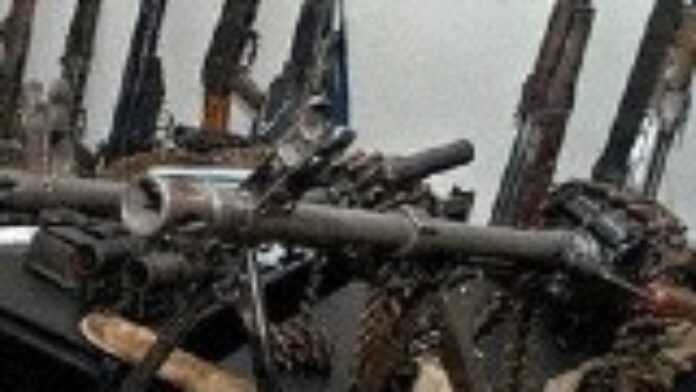
Southern Sudan is planning towards a conflict-free independent nation by embarking on a campaign to withdraw arms from its civil society. Security forces are going from house to house to search and confiscate illegally owned weapons. But despite the fact that the UN has lauded the programme as the largest ever, analysts have cautioned the South Sudanese government to operate with a comprehensive strategy that would encourage lasting peace in the volatile region. Earlier disarmament programmes have not worked in Southern Sudan.
Residents in southern Sudan have been asked to stay at home and roadblocks have been mounted to ensure an effective clean up of illegally possessed weapons. The operation is mostly targeting people in Juba, South Sudan’s capital where the sound of gunshots is still a regular sound at night. Violent crime in Juba has been on the rise as the region is flooded with automatic weapons.
A similar disarmament programme conducted in 2006 blamed for the loss of over 1,000 lives also resulted in gross human rights abuses. According to a report by Eric G. Berman, Managing Director of the Geneva based Small Arms Survey (SAS), that appeared in the Sudan Tribune, the course of the Government of South Sudan’s (GoSS) “initiative that targeted the Lou Nuer and netted some 4,000 weapons” that year (2006), however, shows that “forcible disarmament (does) not work in South Sudan. While it may highlight the government’s commitment to action, it tends to be short-sighted and can result in brutal violence”.
“In September (2008), the army attacked the civilian population in Rumbek, and conducted house-to-house searches for firearms. There were reports of rape and looting; the UN said that seven people were killed and ten wounded. The number of weapons collected during this exercise was estimated to be 333. Most of the confiscated guns belonged to local security forces, and their guns were later returned to them. So the cost of collecting a hundred guns was 21 people killed or wounded,” indicated a report filed by David Kopel, Paul Gallant, Joanne Eisen from the Independence Institute, in Golden, Colorado.
Uneven disarmament means neighboring communities remain armed and could also encourage already disarmed groups to rearm. Campaigns to forcibly collect arms from communities without dealing with the problems at source have also been blamed for the failure of past disarmament programmes. According to Mr. Berman, the scale of “human rights violations, significant internal displacement, and wide-scale looting and food insecurity” led to a subsequent rearming of previously disarmed populations, leading to the programmes failure.
Early this year, a research conducted by the SAS identified; poor planning, Lack of overarching policy, Lack of legal framework, Inadequate engagement of civilian population/communities and Sporadic implementation as some of the factors that led to the failure of the GoSS 2008 disarmament drive.
Although the process to disarm the south that began in February has received recognition by the United Nations as the biggest such operation in history, analysts insist that the best way to halt the violence is to deal with the root cause of the problem. Nhial Tiitmamer of the New Sudan Vision writes that “there is a need for South Sudan to develop a comprehensive strategy that provides an immediate halt to the violence and long term solutions which ensure a durable security, (a) Comprehensive peace and reconciliation strategy which is inclusive, sustainable and which addresses the root causes of the conflict.”
For a lasting and peaceful co-habitation among Southern Sudanese, Mr. Tiitmamer states that guarantees should be made to “include a legal framework that provides accountability through strong governance institutions, monitoring and follow-up and economic incentives to the communities.” “Disarmament”, according to him, should be “community driven.”
The disarmament operation comes a year before national election in 2010 which is to be followed by a referendum in 2011. The government of Omar al-Bashir in Khartoun Sudan had been strongly accused of proliferating arms in southern Sudan to destabilise the southern tribes ahead of a referendum on southern independence. These claims of proliferation compounded by the GoSS’ asymmetric disarmament makes the success of a disarment programme very complex.
“They remember that the central governments of their nations have committed genocide against them in the recent past, and so are unwilling to make their survival dependent on the government’s good will. Current government gun confiscation programs which are implemented by destroying villages, torturing and killing the men, and raping the woman do not exactly inspire confidence that the central government is benign” say David Kopel, Paul Gallant and Joanne Eisen.
South Sudan has been negatively affected by the First and Second Sudanese Civil Wars for all but 10 years since Sudanese independence in 1956, resulting in serious neglect, lack of infrastructure development, and major destruction and displacement. More than 2 million people have died, and more than 4 million are internally displaced or have become refugees as a result of the civil war and war-related impacts.
US envoy to Sudan, Scott Gration is currently in Juba for talks aimed at paving the way for the south to hold a referendum on seceding from the north. The people of southern Sudan dispute census results saying they make up a far smaller proportion of Sudan’s overall population than they believe. “We will concentrate on finding a path forward on the two remaining unresolved sticking points for full Comprehensive Peace Agreement implementation. These are fundamental issues that must be resolved soon,” Mr. Gration is quoted in a statement, as saying.

